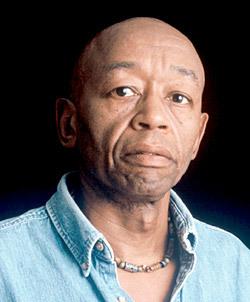
Roland L. Freeman (b. 1936), South Capitol Street at M Street. Washington, D.C., February 1972 (from the series Southern Roads/City Pavements), 1972, printed 1982, gelatin silver print, 11 x 14 in., Smithsonian American Art Museum, Gift of George H. Dalsheimer, © 1972 Roland L. Freeman, 1991.80.1
Student Questions
1. What details on the car make it look stylish? What details indicate that it’s no longer new?
2. Where is the car parked? What details in the photo tell you the car’s location? If you drove through the neighborhood would you likely see this view? If you lived in one of these houses, would you see it?
3. What does the car tell us, if anything, about the neighborhood?
Download This Artwork
About This Artwork
Roland Freeman explores despair, irony, and hope in his photograph of an inner-city neighborhood. In the foreground is a sleek convertible that has seen better days. The tires are flat, the body is patched, the hood is dented, and the back window is damaged. Although designed to look and go fast, this auto is stuck, hidden in an alleyway behind a brick apartment building. The apartments' small backyards and balconies are strung with makeshift clotheslines, sagging with laundry. A man, the only person in the photo, stands in the shadows near the car's pointed "fins."
From the 1950s to the 1970s, many Americans considered a large, expensive car to be the ultimate status symbol. For many living in black, urban neighborhoods, such cars were all the more desirable because they were so difficult to obtain. During this period, many middle-class families, both white and black, deserted cities for more comfortable suburban settings. Meanwhile, the problems of people remaining in urban centers multiplied. With a smaller tax base, services and schools declined, and with fewer consumers, businesses left, taking jobs with them and perpetuating inner-city decline.
Even as some African Americans ensured monetary success for their families, in many cities two separate societies developed side-by-side: one poor and predominately black, the other prosperous and mostly white. In Washington, D.C., where Freeman took this photograph fewer than five years after rioting that followed Martin Luther King Jr.'s 1968 assassination, the differences between "the two Washingtons" seemed deeply ironic. On the one hand, the District was the capital of the world's richest country and a global symbol of democracy and opportunity. On the other hand, throughout the twentieth century, a majority of black Washingtonians lived in poverty.
Given this background, Freeman's stranded, once-beautiful driving machine becomes a symbol of a distressing lack of mobility. Freeman, however, adds something to this all too familiar picture of urban inequity and poverty: the car and the freedom it symbolizes poignantly convey the dreams and desires of inner-city inhabitants.
About This Artist
Roland L. Freeman (born Baltimore, MD 1936)
Roland Freeman has dedicated his life to documenting through photography the complex and varied lives of African Americans, producing work he hopes will “capture a moment and evoke a sense of time and place.” In the 1960s, Freeman became a freelance photographer, focusing on the Civil Rights movement. He has since worked as a photojournalist and researcher, collaborating with folklorists, historians, sociologists, and community activists to create a record of American culture. His photographs have appeared in magazines around the world and have been published in his books, which explore themes such as quilting in the South, African American communities in places like Philadelphia and Baltimore, and gospel music. Based in Washington, D.C., Freeman founded The Group for Cultural Documentation (TGCD) in 1991 to increase appreciation of cultural traditions through preservation, documentation, and exhibitions. In 2007, the National Endowment for the Arts awarded Freeman the Bess Lomax Hawes Award, America’s highest honor in the folk and traditional arts. His ongoing project, “While There Is Still Time,” uses photographs to research and interpret the continuity of cultures and traditions throughout the African Diaspora.
Related Material

Robert McNeill, New Car (South Richmond, Virginia), (from the project The Negro in Virginia), 1938. Gelatin silver print, 10 x 8 in. Smithsonian American Art Museum, Museum purchase, © 1938 Robert McNeill, 1993.72.5
While Freeman’s dated car suggests poverty, Robert McNeill’s photo shows people reveling amid a shining new auto—a symbol of prosperity and success. The broad smile and carefree stance of the man in the vest assures us that he is the owner. This picture celebrates a rare moment of success during the Great Depression, when unemployment and economic distress engulfed the nation. As a photographic consultant for the Works Progress Administration, McNeill photographed people at work and at play while traveling through Virginia.

Milton Williams, Displaced Washington D.C. Shaw neighborhood residents, September 1977. Gelatin silver print. © Milton Williams, Collection of National Museum of African American History and Culture, Gift of Milton Williams Archives
Milton Williams, Shaw neighborhood child rides his tricycle, October 1973. Gelatin silver print. © Milton Williams, Collection of National Museum of African American History and Culture, Gift of Milton Williams Archives
Like Roland Freeman’s photograph, Milton Williams’s photos of 1970s Washington, D.C., explore African American mobility, in both the economic and physical senses. In one photograph a neighborhood child rides his tricycle on the sidewalk in front of an abandoned house. In a second, residents protest the building of a parking lot that ultimately, despite their objections, razed their homes. By focusing on expressive movement—the child’s and the demonstrators'—and on constrained economic mobility—the dilapidated home and the residents’ displacement—Williams presents a complex theme.















